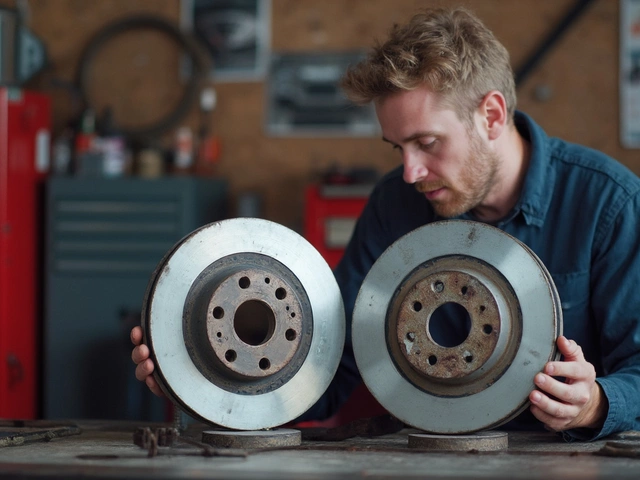When you revamp your car with an upgraded exhaust system, the transformation can feel remarkable. More power, a deeper growl, and potentially better fuel efficiency might entice you. However, to truly get the best out of this upgrade, you might need to consider tuning your vehicle.
Tuning isn’t just for car enthusiasts or racers; it can offer tangible benefits for everyday drivers too. Understanding how your new exhaust affects the engine’s air-fuel mixture is crucial. This balance impacts everything from horsepower to how smooth your ride feels.
In this article, I will guide you through why and how you should tune your car following an exhaust system upgrade. From understanding the inner workings of exhaust systems to practical tips on maintaining your vehicle post-tuning, we've got you covered.
- Understanding Exhaust Systems
- Benefits of Exhaust Upgrades
- The Necessity of Tuning
- How Tuning Works
- Common Tuning Methods
- Maintenance Tips Post-Tuning
Understanding Exhaust Systems
Exhaust systems are the unsung heroes of our vehicles, responsible for much more than just channeling exhaust gases away from the engine. At their core, these systems manage exhaust flow, reduce noise, and keep harmful gases out of your cabin. Each component, from the manifold to the tailpipe, plays a critical role in how your car breathes and performs. The journey begins with the exhaust manifold, which collects gases from each cylinder. This early stage is crucial; if the manifold doesn’t efficiently gather these emissions, performance can dip significantly.
Modern exhausts often include a catalytic converter, a device invented in the 1970s with a single mission: to transform harmful pollutants into less dangerous emissions before they reach the open air. These converters use precious metals like platinum and palladium, making them both effective and unfortunately, expensive. A well-functioning catalytic converter can convert up to 98% of harmful gases—like carbon monoxide—into carbon dioxide and water vapor. It’s a stunning feat of chemical engineering that keeps our environment just a bit cleaner.
The next stop for these gases is the exhaust pipe and muffler—a structure commonly misunderstood as just a sound reducer. While it's true that mufflers play a huge part in silencing those explosive sounds that engines naturally produce, they also maintain optimal back pressure. This balance impacts horsepower, aiding the engine in producing power efficiently. The geometry and design of the pipe have a significant effect; a wider pipe typically means more exhaust flow and, potentially, more power. However, bigger isn’t always better—just like how controlling air intake is crucial, managing exhaust flow effectively is a delicate dance of balance.
Why all this focus on exhaust systems? Because they contribute directly to both the car’s performance and its environmental footprint. An optimized exhaust system can boost fuel efficiency and enhance the overall driving experience by ensuring the engine is running as clean and efficiently as possible. Not to mention, a sporty exhaust roar can immensely please car enthusiasts. As Charles Goodyear famously said, “My luck is improving. One of my tires was stolen last night, so I got a perfect night's sleep.” Similarly, a stellar exhaust system doesn't demand attention; it simply works in harmony, ensuring peace of mind.
When considering an upgrade, knowing your car's current system is key. You should assess if you need a more straightforward swap or a complete overhaul of components. A common misconception is that exhaust systems upgrade automatically boost speed and power, but it’s not as simple. Consider an aftermarket exhaust, for instance, which may optimize various aspects of performance but could also affect noise or emissions compliance. States in the U.S., like California, have strict regulations, so understanding local laws is vital before making such changes.
Benefits of Exhaust Upgrades
Upgrading the exhaust system of your car is a game-changer that can significantly enhance performance and the driving experience. A high-quality aftermarket exhaust system improves the efficiency of how exhaust gases exit the engine, which allows for a better intake of fresh air. This process boosts horsepower, offering a noticeable increase in your car’s power. Many car enthusiasts find that the right exhaust upgrade can add an additional 5 to 10 percent to their horsepower, depending largely on the make and model of the vehicle. The unrestricted flow of gases doesn’t just increase power; it also enhances throttle response, making your vehicle more responsive and agile on the road. For those who value a quick getaway at a traffic light, this improvement is highly desirable.
Of course, it’s not just about power. Many people upgrade their exhaust systems to improve fuel economy. An efficient exhaust system reduces engine workload by allowing it to breathe easier, which can improve fuel efficiency by up to five percent in some cases. This puts less stress on the engine and can result in fewer trips to the petrol station, a benefit anyone would appreciate today. An example of this is shown in a study where vehicles with upgraded exhausts demonstrated lesser fuel emissions, proving an improvement in their efficiency.
The sound is another cherished advantage. A proper exhaust upgrade can transform the humble hum of your car into a thrilling roar, a feature particularly sought after by sports car enthusiasts. This auditory upgrade is all about the acoustic quality of the exhaust note. Some premium exhaust systems even allow drivers to switch between different sound profiles, so they can adjust how loud or soft they want their car to be at the push of a button.
"An exhaust system is like a car’s voice – it defines if you’re heard with a whisper or a roar,” said a prominent automotive engineer from the world-renowned motoring magazine 'Top Gear'.
The aesthetic improvements should not be underestimated either. Aftermarket exhaust upgrades often add a sleek, polished look to the rear end of your vehicle. This is important not just for vanity but for aerodynamics, as well. A well-designed system can offer a slight boost in aerodynamics by reducing drag, which, in the right conditions, can further enhance performance. So, whether you’re on the open road or stuck in city traffic, a quality exhaust system can make all the difference—making your car smarter, sleeker, and more efficient.
The Necessity of Tuning
When you enhance your car with a new exhaust system, it might feel a bit like putting a lion's heart in a gazelle's body. Unless you tune your vehicle to adapt to the new dynamics, the change won't be as satisfying or effective as you hope. A high-performance exhaust isn’t just about noise and aesthetics. The core function revolves around optimizing the car's exhaust flow, which directly affects the engine’s air intake and fuel combustion. Without a proper tune-up, you could find your car running too rich or too lean, both of which could lead to inefficient fuel consumption and reduced performance.
The concept of car tuning after an exhaust modification isn't merely a suggestion—it’s often a necessity. The car’s computer, also known as the Engine Control Unit (ECU), was originally programmed with specifications to operate within a particular set of parameters. When you change major components like the exhaust, these parameters can become misaligned. This misalignment can lead to a suboptimal air-fuel ratio, which can undermine the potential gains of the exhaust upgrade in terms of power and efficiency. In a quote by James McKean, a renowned expert in automotive engineering, "A vehicle's soul is its engine, and tuning is akin to finding that perfect harmony between its elements." Never underestimate the potential of tuning to transform your driving experience.
In a practical sense, tuning involves adjusting the settings of the ECU so it can accommodate the new dynamics brought by the improved exhaust. Think of it as recalibrating the system for enhanced functionality. It often involves multiple steps, starting with a diagnostic scan to identify areas requiring adjustment. Then, it checks the timing, air-fuel mixture, and ignition settings. Done right, this process can unlock substantial horsepower gains and increase throttle response, making your vehicle's performance crisper and more responsive.
Not every journey into tuning ends the same way. The path depends on your car model, the type of car tuning required, and the extent of modifications done with the new exhaust. For some, it might involve a simple retune of the ECU, while others might require more extensive tuning sessions, perhaps even considering a switch to aftermarket performance chips or modules. Lists of steps, if your tuning route takes a more intricate path, might resemble this:
- Conduct a preliminary performance assessment.
- Use diagnostic tools to scan the ECU's mapping.
- Adjust the air-fuel ratio to match the vehicle's new exhaust needs.
- Test ignition timing against performance under load.
- Reassess, noting improvements and areas needing further adjustment.
Moreover, it's crucial to understand the tuning's ongoing nature. Following the initial setup, periodic checks can help ensure the vehicle maintains its peak performance. In some cases, enthusiasts enjoy the continuous tweaking that accompanies car tuning, treating it as a continuous enhancement ritual rather than a one-off task. After all, every tune can reveal a new layer of potential in your vehicle.

How Tuning Works
Delving into the world of vehicle tuning can seem daunting if you are new to the game, but it's all about finding the perfect balance. After an exhaust upgrade, everything in your car has to work in harmony. Think of it as fine-tuning a musical instrument—every tweak matters. Your engine breathes better now, but tuning adjusts the air-to-fuel ratio, optimizing combustion so you can extract more power and efficiency from your setup.
When the exhaust system is changed, it can alter the way the engine manages its exhaust gases and intake air. This means your engine control unit (ECU), the brain behind your car’s performance, needs a reflash or remap. This process involves rewriting the ECU’s existing software to match new air and flow dynamics. This can be as simple as using a tuning box or a more complex task requiring specialized tuning software and a technician. How intricate the process gets depends largely on how extensive the changes are.
"Tuning must blend science with an artful touch," says John Nistor, a respected performance tuning specialist. "Each car has its own needs and potential, and you bring those unique qualities to life to get the best result."
The tuning process often starts with a dyno test. This involves placing your car on a dynamometer, a piece of equipment that provides an accurate reading of horsepower and torque before any tuning begins. This benchmark is crucial for understanding what gains are made. Once the initial test is done, additional runs measure the effect of individual adjustments, whether you're dialing in more air via the air intake or improving exhaust flow.
Adjustments and Methods
There are several common approaches when it comes to tuning. An ECU remap is one of the most popular due to its ability to precisely adjust the car’s performance parameters. Another method is piggyback tuning, which involves adding a separate module to override certain signals from the ECU. This method is less intrusive but may not provide the same level of customization. Some enthusiasts opt for standalone engine management systems offering unparalleled control in your tuning endeavors.
Interestingly, recent statistics highlight that well-tuned engines can increase fuel efficiency by up to 20% while lowering harmful emissions. A study conducted by the Automotive Research Institute also revealed that the performance gains from proper tuning, following an exhaust upgrade, can range from 5% to a staggering 15% increase in horsepower, dependent on the vehicle model and tuning integrity.
Ultimately, the key with tuning is to ensure that each modification aligns with your driving preferences. Whether you are seeking raw power, better fuel efficiency, or a happier medium, the tuning process can cater to your specific desires. The saying 'one size fits all' doesn't apply here, as each car presents its own unique combination of traits. By indulging your vehicle with post-exhaust adjustments, you forge a stronger, more refined identity on the road.
Common Tuning Methods
Tuning your car after an exhaust upgrade is crucial to unlock its full potential. Many drivers venture into the world of tuning and might feel overwhelmed by the array of methods available. Each technique has its unique benefits and is suitable depending on what you're looking to achieve in vehicle performance. Understanding these methods can help you make an informed decision.
One prevalent tuning approach is the ECU (Engine Control Unit) remapping. This method involves modifying the software inside the ECU, which controls engine operations. Remapping can enhance horsepower and improve fuel efficiency. It is one of the most direct ways to ensure the engine and the new exhaust system are in sync. According to the automotive publication Car and Driver, "ECU tuning is like giving your car a brain transfusion; it gets smarter, faster, and more efficient." You’ll find tech experts offering this service in most regions, making it a popular choice.
Another common method is piggyback tuning, where an additional electronic module is installed alongside your existing ECU. Unlike remapping, this doesn't alter the factory settings permanently. Instead, the piggyback modifies signals before they reach the ECU. This slight alteration can deliver boosts in performance and is favored by those keen to keep original factory settings intact. Many car enthusiasts appreciate the flexibility it offers, as you can easily reverse the modifications.
For those more inclined to hands-on tuning, manual methods such as adjusting the air/fuel mixture and ignition timing can also bring significant improvements. This approach demands a good understanding of engine mechanics. It’s about tweaking the mechanics manually, often involving the physical adjustment of engine components. Although it requires more labor, there’s something incredibly satisfying about fine-tuning your car by hand. The modifications might involve increased time and effort initially, but they can perfectly cater to the unique needs of your vehicle.
It's not just about remapping or piggyback setups when it comes to vehicle maintenance. Some drivers combine these methods with mechanical tuning changes like installing performance parts. These might include performance air filters, upgraded fuel injectors, or enhanced ignition systems. A comprehensive approach can augment the performance gains from your new exhaust system.
Whichever method you choose, it’s vital to remember that tuning can affect your car’s warranty. Some manufacturers might view these modifications as changes that void their coverage. Checking with your warranty provider is smart before implementing any significant tuning changes. Additionally, some countries have regulations on how far tuning modifications can go without breaching emissions standards. Always research the rules in your region to avoid any setbacks.
Maintenance Tips Post-Tuning
After you've decided to tune your car following an exhaust upgrade, maintaining that peak performance becomes your next mission. One crucial aspect of post-tuning maintenance is regular engine checks. With a new exhaust system in place and the engine finely tuned, it's vital to monitor engine health closely. Look out for any unusual noises or vibrations, as they might indicate something amiss with the tuning or the exhaust itself. Many drivers notice that their vehicle runs hotter after an upgrade, so keep an eye on temperature gauges. Understanding these minor nuances can prevent major mechanical issues down the line.
Tuning not only gives your vehicle a performance boost but also reshuffles its internal conditions. Regular oil checks are now more important than ever. With altered engine dynamics from tuning, it's recommended to change the oil more frequently. This will help in ensuring the lubricants are fresh and capable enough to cope with the enhanced pressures. On a related note, using high-quality fuel and oil can make a significant difference in maintaining the engine’s efficiency. A compelling study from the prestigious journal 'Automotive Science and Engineering' highlighted that vehicles using premium oil had a 15% higher efficiency post-tuning.
Another often overlooked aspect is the air filter, which tends to accumulate more dust and debris after a car is tuned. This happens because the engine may draw more air to meet the new settings post-upgrade. Therefore, it’s wise to check and replace the air filter regularly. Neglecting this could hamper performance and negate some benefits of your upgraded exhaust. If you live in dusty areas, consider using filters specifically designed to capture finer particles.
"The small investment in a high-quality air filter can extend your engine life significantly," cites automotive expert James Peterson, whose insights in vehicle dyno testing are widely respected.
Maintaining tire pressure is critical too. After all, a car with dynamically changed performance characteristics will behave differently on the road. Maintaining the right tire pressure helps in achieving optimum grip and handling, attributes that are even more noticeable once the car's performance has been tuned. According to a survey by the UK-based 'Motoring Journal', appropriately inflated tires can improve vehicle mileage by up to 10%, which is often a concern post-tuning as enhanced power can lead to increased fuel consumption.
Finally, pay attention to the electronics in your vehicle. Tuning often involves reprogramming the ECU (Engine Control Unit), and just a small glitch here can, over time, manifest into inefficiency or performance lags. Running regular diagnostics can catch any anomalies early. Investing in a high-quality OBD scanner might sound excessive, but it's a small price for peace of mind in the world of car tuning.






